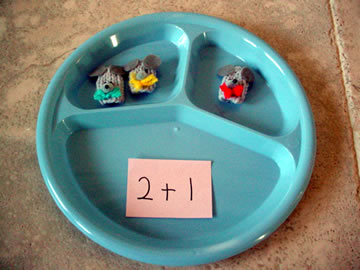Please upgrade to the latest version of Flash Player.
Click here if you already have Flash Player installed.
Please upgrade to the latest version of Flash Player.
Click here if you already have Flash Player installed.
15) Plastic Plate Addition
When doing addition problems, give children a divided plastic plate. They can make sets in the small sections and then join them together and count in the larger section. Hint! You can also use divided plates for onsets and rimes. Write onsets on 1 ½ ” squares of paper and place in one section. Write rhymes on 1 ½” x 2 ½” rectangles and place in the other small section. Children choose a card from each section and put them together in the larger section and read the word they have made. (It can be a “real” word or a nonsense word.) Click photo for larger image. |
16) Money Signs
Reinforce coin value by adapting “high five.”
|
17) Sticky Notes
|
Use sticky notes to encourage writing and reinforce
functional print. “Get a sticky note and write it down
so you don’t forget.” “Put a sticky note on your desk
about riding home with your aunt.” “Put a sticky note
in the book when you find the solution.” |
18) Interest Inventory
In addition to saving writing samples and self portraits in a “portfolio” each month, have children complete an “interest inventory” by filling in sentences similar to the ones below: I am good at______.
|
